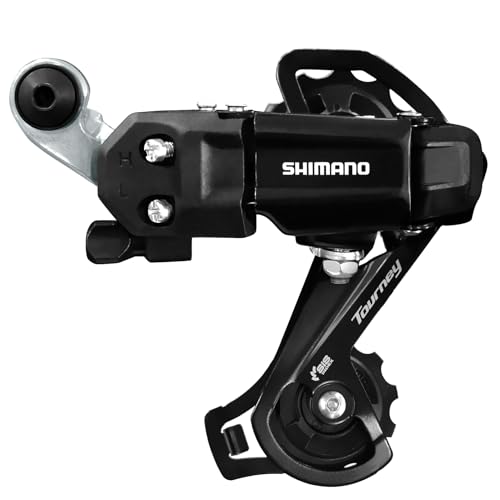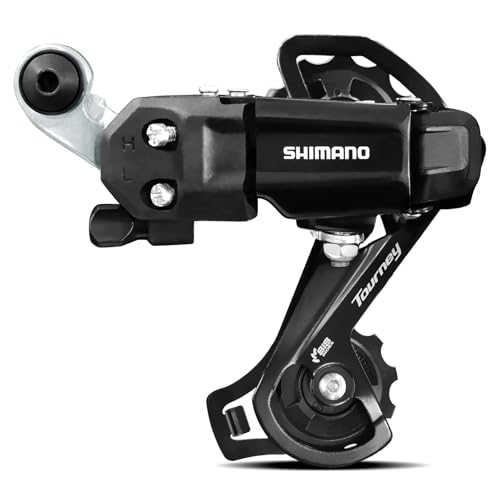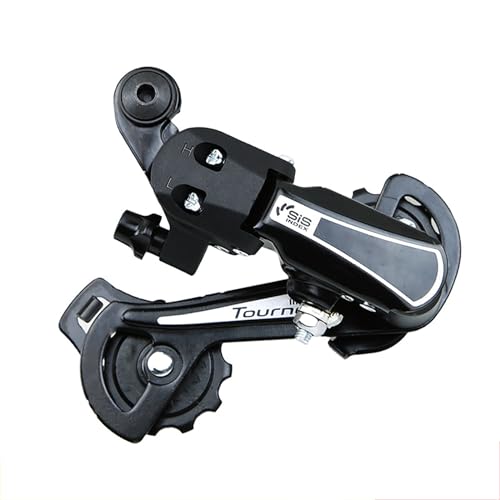Understanding Gear Shifting
Gear shifting is a fundamental aspect of cycling that plays a crucial role in a cyclist’s overall performance, comfort, and efficiency during rides. At its core, gear shifting refers to the ability to change the gear ratio of a bicycle, allowing for adjustment in the difficulty of pedaling relative to the terrain. By shifting gears, cyclists can optimize their exertion according to varying conditions, whether they are climbing steep hills, navigating flat roads, or descending slopes.
The mechanics behind gear systems are relatively straightforward yet can significantly impact a rider’s experience. Most modern bicycles are equipped with derailleurs, which are small mechanisms that shift the chain from one gear to another. This shifting is controlled by the bicycle’s shifters, located on the handlebars. Understanding how these components operate together helps cyclists efficiently manage their cadence and power output. For instance, switching to a lower gear makes pedaling easier, reducing fatigue on challenging inclines, while higher gears are suited for flat or downhill terrains, enabling greater speed and efficiency.
The significance of effective gear shifting is further underscored by its influence on energy management during long rides. By making optimal gear choices, cyclists can maintain a consistent level of exertion, thus avoiding excessive muscle strain and enhancing their endurance. This strategic approach to gear shifting allows riders to comfortably navigate diverse terrains without compromising their overall performance.
Ultimately, mastering gear shifting is essential not only for competitive cyclists aiming to gain an edge but also for casual riders seeking to improve their cycling experience. By gaining a deeper understanding of gear systems and their interactions with different terrains, cyclists can enhance their rides, making them more enjoyable and efficient.
Common Issues with Gear Shifting
Gear shifting is a critical function for cyclists, ensuring a smooth transition between different gears that can enhance performance and comfort. However, many cyclists encounter a variety of issues while attempting to shift gears effectively. Understanding these common problems can facilitate better diagnosis and proposed solutions.
One prevalent issue is gear skipping, where the chain fails to engage with the selected gear properly. This often occurs due to a worn or damaged chain, cassette, or derailleur. The misalignment of components can also lead to this problem. Riders may notice an audible sound when the chain jumps across gears, which can disrupt riding flow and create frustration.
Another frequent concern is experiencing delays in gear shifting. This lag occurs when there is poor cable tension or stiffness in the derailleur mechanism. Factors contributing to this issue may include dirt accumulation or inadequate lubrication of moving parts, hindering optimal performance. Cyclists may find that they need to apply more effort or time to shift gears, which can lead to inefficiencies during rides.
Grinding noises while shifting represent yet another common problem and can often cause considerable concern. This sound usually indicates that the chain is not aligning correctly with the gear or that the components are out of adjustment. Possible causes for grinding noises include misaligned derailleurs, incorrect chain length, or worn-out sprockets. Addressing this issue promptly is crucial, as continued grinding can lead to further damage and increased costs for repairs.
By recognizing these issues—gear skipping, delayed shifting, and grinding noises—cyclists can more effectively troubleshoot their gear systems. Understanding the potential causes will enable them to make necessary adjustments or seek professional help, ensuring a smoother riding experience.
Essential Tools for Gear Adjustment
To ensure smooth gear shifting and optimal performance of your bicycle, it is imperative to have the essential tools for gear adjustment at your disposal. A well-equipped toolkit can make the process of maintenance significantly easier and more efficient, ultimately enhancing your riding experience.
First and foremost, a set of screwdrivers is essential. A flat-head and a Phillips screwdriver are typically required for various adjustments on your bike’s derailleur and shifters. When selecting screwdrivers, consider tools that are ergonomically designed for better grip, which allows for precise adjustments without excessive effort. Magnetic tips can also be a useful feature to help prevent lost screws during maintenance.
Additionally, a set of wrenches, particularly a multi-tool that includes different sizes, is vital for making adjustments to components like the derailleur and shifter. Adjustable wrenches can also be beneficial, as they adapt to fit various nut sizes on your bike. When choosing wrenches, opt for those made from high-quality materials to withstand wear and tear, ensuring longevity and durability.
Furthermore, consider incorporating a torque wrench into your toolkit. This specialized tool allows you to apply the correct amount of force when tightening components, which is crucial for maintaining optimal performance without damaging parts. Proper torque settings are essential for achieving reliable gear shifting.
Lastly, having a quality chain tool is important for maintaining the bike’s drivetrain. This tool facilitates chain installation and removal, allowing for easy replacements when necessary. When investing in tools for gear maintenance, prioritize reputable brands known for their durability and reliability. Quality tools not only improve your maintenance routine but also ultimately contribute to smoother rides.
How to Fine-Tune Your Derailleurs
Fine-tuning your derailleurs is essential for achieving smooth gear transitions while cycling. This process involves several critical adjustments, including cable tension settings, limit screw configurations, and alignment checks. To begin, it is important to focus on the rear derailleur, as it plays a vital role in shifting between gears on the cassette.
Firstly, inspect the cable tension of the derailleur. To adjust the cable tension, shift to the highest gear (smallest cog), which allows you to access the adjustment barrel located on the derailleur or shifter. Turn the barrel clockwise to increase tension or counterclockwise to decrease it. A well-tuned cable tension ensures that the derailleur moves precisely and responds promptly to shifting commands.
Next, limit screws must be adjusted to prevent the chain from moving beyond the largest and smallest cogs. The rear derailleur typically features two limit screws marked “H” for high limit (smallest cog) and “L” for low limit (largest cog). Start by shifting into the largest cog, and adjust the “L” screw until the derailleur aligns perfectly with this cog. Repeat the process for the “H” screw while shifting to the smallest cog.
For the front derailleur, the procedure is akin to that of the rear derailleur. Inspect the alignment to ensure it is parallel with the chainrings. To adjust, loosen the mounting bolt and position the derailleur about 1-3 mm above the tallest tooth of the largest chainring. After this, fine-tune the cable tension similarly by using the barrel adjuster, ensuring that each shift is crisp and responsive.
Finally, a thorough test ride is crucial. Verify that each gear shifts seamlessly under load. If issues persist, revisit cable tension and limit screws to achieve optimal performance. Through these systematic adjustments, your derailleurs will provide smooth and efficient gear transitions, significantly enhancing your cycling experience.
Regular Maintenance Practices
Maintaining your bicycle is critical for ensuring optimal gear performance, which directly impacts your riding experience. Regular maintenance practices not only prolong the life of your bike but also enhance the accuracy and smoothness of gear shifts. One of the most essential routines involves cleaning the drivetrain. Accumulated dirt and grime can significantly hinder gear operation, leading to rough shifts and increased wear on components. To clean the drivetrain effectively, remove excess debris with a gentle brush and employ a suitable degreaser to eliminate stubborn residues, making certain to rinse thoroughly and dry afterward.
Another crucial aspect of gear maintenance is lubricating the chain. A well-lubricated chain provides a smoother transition between gears and reduces friction, which is vital for efficient riding. Apply chain lubricant evenly, taking care not to over-saturate, as excess lubricant can attract dirt and dust, leading to a cycle of buildup. After lubricating, wipe off any excess with a clean rag to ensure optimal performance.
Additionally, regularly checking the overall condition of the bike can catch potential gear shifting issues before they escalate. This includes inspecting the gear cables, ensuring they are clean and properly tensioned, and checking the derailleur for alignment. Any misalignments can lead to problematic shifts, so adjusting them accordingly can make a significant difference. Consistent inspection of tires and brakes is equally important, as these components can affect bike stability during gear transitions. By adhering to these maintenance practices, enthusiasts can ensure a smoother and more reliable riding experience, reducing the likelihood of unforeseen gear-related problems in the future.
Rider Technique for Smooth Shifting
Mastering the technique of gear shifting is vital for any cyclist seeking a smoother ride and enhanced performance. A successful shift not only involves the bike’s mechanics but also the rider’s technique and awareness. Therefore, it is essential to understand various practices that can lead to seamless gear transitions. One of the crucial aspects of effective shifting is timing. Riders should aim to shift gears during a period of minimal pedal pressure, such as when they are at the apex of their pedal stroke. This helps prevent unnecessary strain on the bike’s components and results in a smoother transition.
Maintaining a consistent cadence during rides significantly influences the quality of gear shifts. Cyclists are encouraged to find their optimal cadence, which is typically between 70 to 100 revolutions per minute for most riders. Staying within this range ensures that the cyclist can efficiently power through shifts without jarring motions that can disrupt momentum. Furthermore, practicing gradual shifts rather than abrupt ones promotes better drivetrain performance and prolongs the life of the gears.
Body positioning also plays a vital role in achieving smooth gear changes. Riders should engage their core and maintain an upright position, particularly while anticipating shifts. Leaning too far forward or backward can affect balance and control, making it difficult to shift gears smoothly. Instead, keeping a steady grip on the handlebars while ensuring proper elbow positioning can aid in maintaining optimal bike control during shifts.
Ultimately, developing these techniques requires practice and patience. Cyclists should take the time to experiment with their shifting habits, observing how different factors such as cadence and body positioning affect their performance. By honing these skills, riders can achieve a more seamless and enjoyable cycling experience, marked by smooth gear transitions that enhance overall efficiency and control on the road.
Upgrading Components for Better Performance
Upgrading bike components can be a transformative decision for cyclists looking to enhance their performance and overall riding experience. The three primary components to consider for upgrades are gear shifters, derailleurs, and chains. Each of these elements plays a crucial role in the gear shifting mechanism and can significantly improve efficiency, responsiveness, and durability when they are of high quality.
Starting with gear shifters, modern advancements offer a variety of features, including ergonomic designs, improved response times, and smoother engagement. Upgrading to a more advanced model can lead to quicker shifts, allowing cyclists to adapt faster to changing terrains and conditions, ultimately contributing to a more enjoyable ride. It is often beneficial to invest in shifters when consistent or problematic shifting becomes apparent, as this could indicate wear or incompatibility with existing components.
Next, consider the derailleurs, which are crucial for the precise movement of the chain across the gear cogs. A well-maintained and high-quality derailleur can enhance shifting accuracy and reduce the likelihood of chain drops or misalignments. If you find that your current derailleur is struggling to keep up with demanding riding conditions, or if it lacks compatibility with your upgraded shifters, an upgrade could enhance your overall performance significantly.
Finally, the chain is often overlooked but is vital to smooth gear shifting. A worn or low-quality chain can lead to poor shifting performance and increased wear on other components. When investing in upgrades, it’s advisable to consider replacing the chain alongside the shifters and derailleurs, as this ensures compatibility and maximizes the effectiveness of the new components.
In essence, upgrading these components is a strategic decision that can lead to marked improvements in gear shifting performance. Regular assessment of component conditions will guide when it is most appropriate to make these upgrades, ultimately providing a more enjoyable and efficient cycling experience.
Training for Better Gear Management Skills
Developing proficient gear management skills is essential for enhancing one’s driving experience, especially in varying conditions. The ability to shift gears smoothly can significantly improve vehicle handling, safety, and overall ride enjoyment. One effective strategy for improving gear shifting is through deliberate practice in controlled environments. Practicing these techniques can boost confidence and ensure a more responsive driving experience.
One useful drill involves setting up a closed course where drivers alternate between rapid acceleration and deceleration. This can be achieved by driving through a series of cones that simulate real-world obstacles. During this exercise, focus should be on maintaining optimal engine RPM while seamlessly shifting through the gears. This drill not only aids in developing muscle memory but also emphasizes the importance of timings, such as when to upshift or downshift based on speed and engine performance.
Another effective practice involves simulating different driving conditions. Practicing gear shifts on inclines, declines, and uneven surfaces can help familiarize drivers with the vehicle’s response in various scenarios. Such conditions require different approaches to gear shifting, making it vital for drivers to understand how their vehicle behaves in these situations. Reflection after each session helps in identifying areas of improvement, allowing drivers to make necessary adjustments sooner rather than later.
Additionally, consider utilizing simulators or advanced driving courses where instructors can provide real-time feedback on driving techniques. Engaging with experienced trainers can expose individuals to refined methods of gear management, incorporating insights that may not be immediately apparent during self-practice. Through committed training and a focus on developing gear management skills, drivers can achieve smoother rides and elevate their overall driving performance.
Conclusion and Final Thoughts
Mastering gear shifting is a crucial aspect of enhancing the cycling experience, contributing not only to performance but also to overall rider enjoyment. Throughout this discussion, we have explored various techniques that can lead to smoother gear transitions, enabling cyclists to maintain a steady cadence and optimal speed regardless of terrain conditions. Proper gear shifting techniques are not merely about efficiency; they also play a significant role in preventing mechanical issues and prolonging the lifespan of bicycle components.
Additionally, regular maintenance and knowledge of your bike’s gearing system are paramount for achieving a seamless riding experience. By familiarizing oneself with the intricacies of gear mechanisms and undertaking routine checks, cyclists can significantly reduce the risk of unexpected disruptions during rides. The importance of adjusting gear settings and ensuring clean components cannot be overstated, as these factors contribute directly to effective gear shifting.
Moreover, the benefits of mastering gear shifting extend beyond immediate performance. A well-practiced cyclist not only rides with enhanced comfort but also gains confidence in tackling various challenges on the road. As you integrate these expert tips into your cycling routine, remember that continued learning and practice will lead to improved proficiency. Each ride offers an opportunity to refine your skills and deepen your understanding of bike maintenance.
In conclusion, embracing the art of gear shifting and committing to consistent care of your bicycle will undoubtedly pave the way for smoother rides and a more fulfilling cycling journey. As you embark on your next adventure, keep these principles in mind to enjoy the many rewards that come with improved cycling techniques and equipment knowledge.
CHECK OUT THE BEST SELLING REAR DERAILLEUR ON AMAZON




